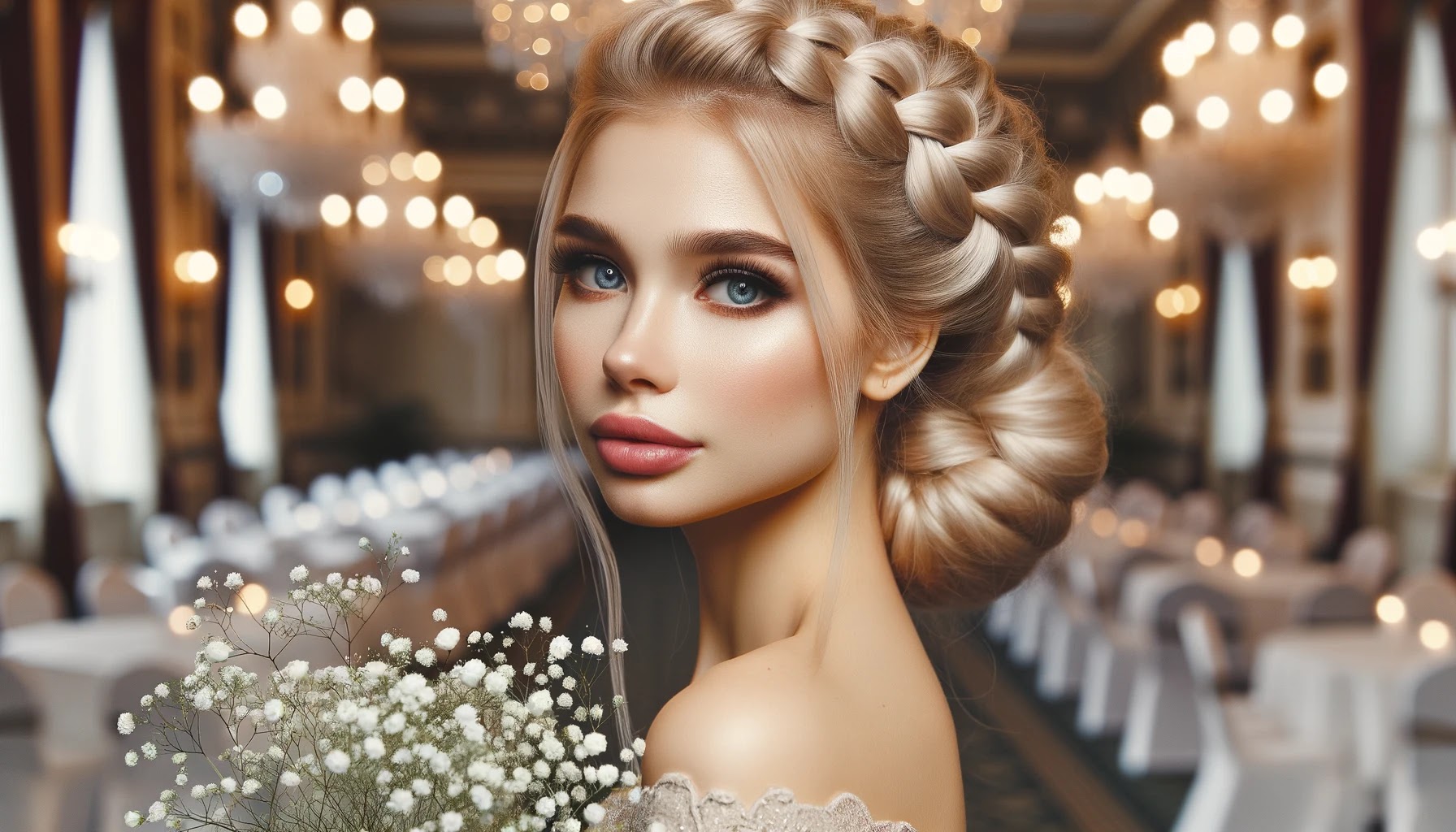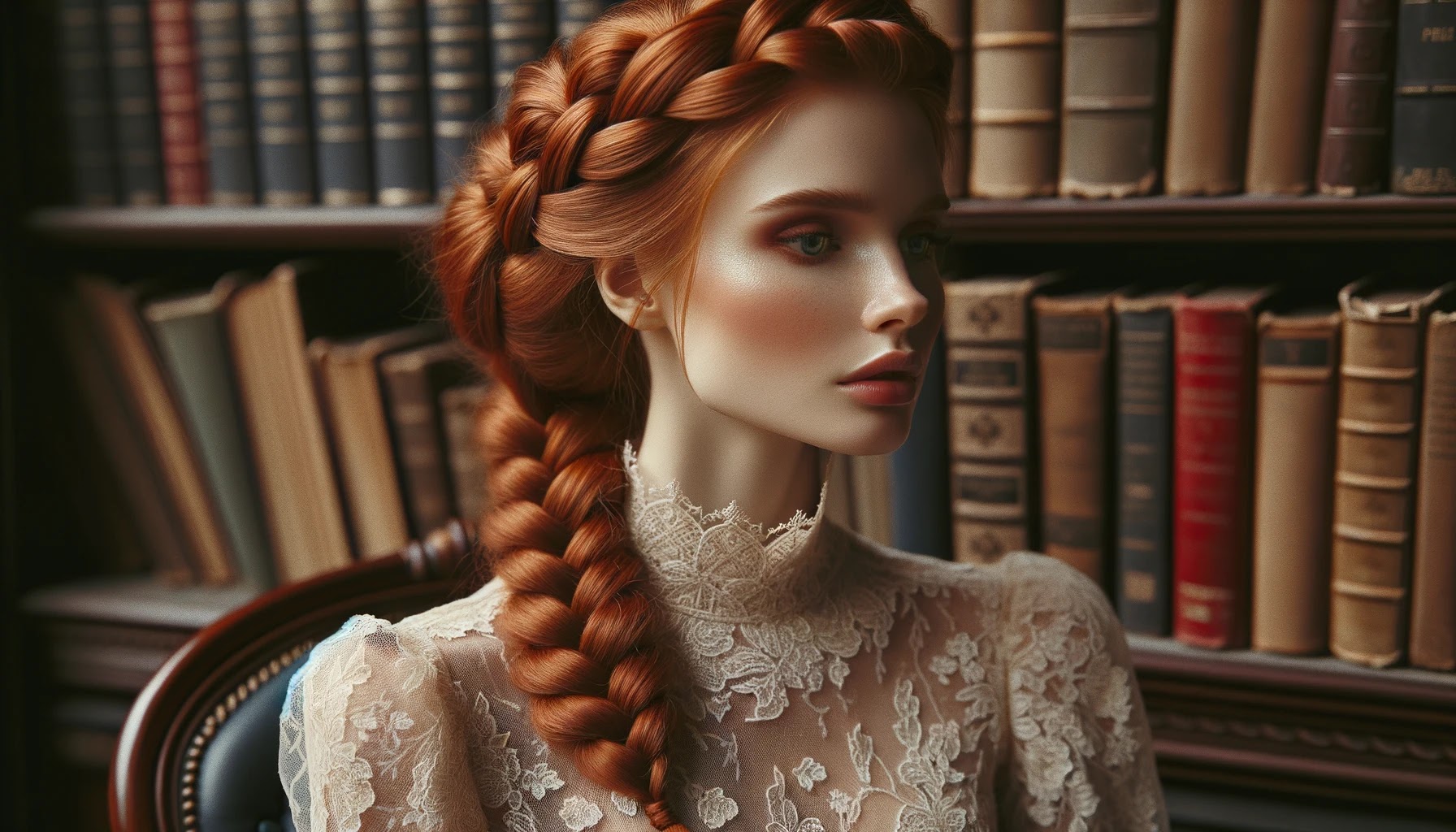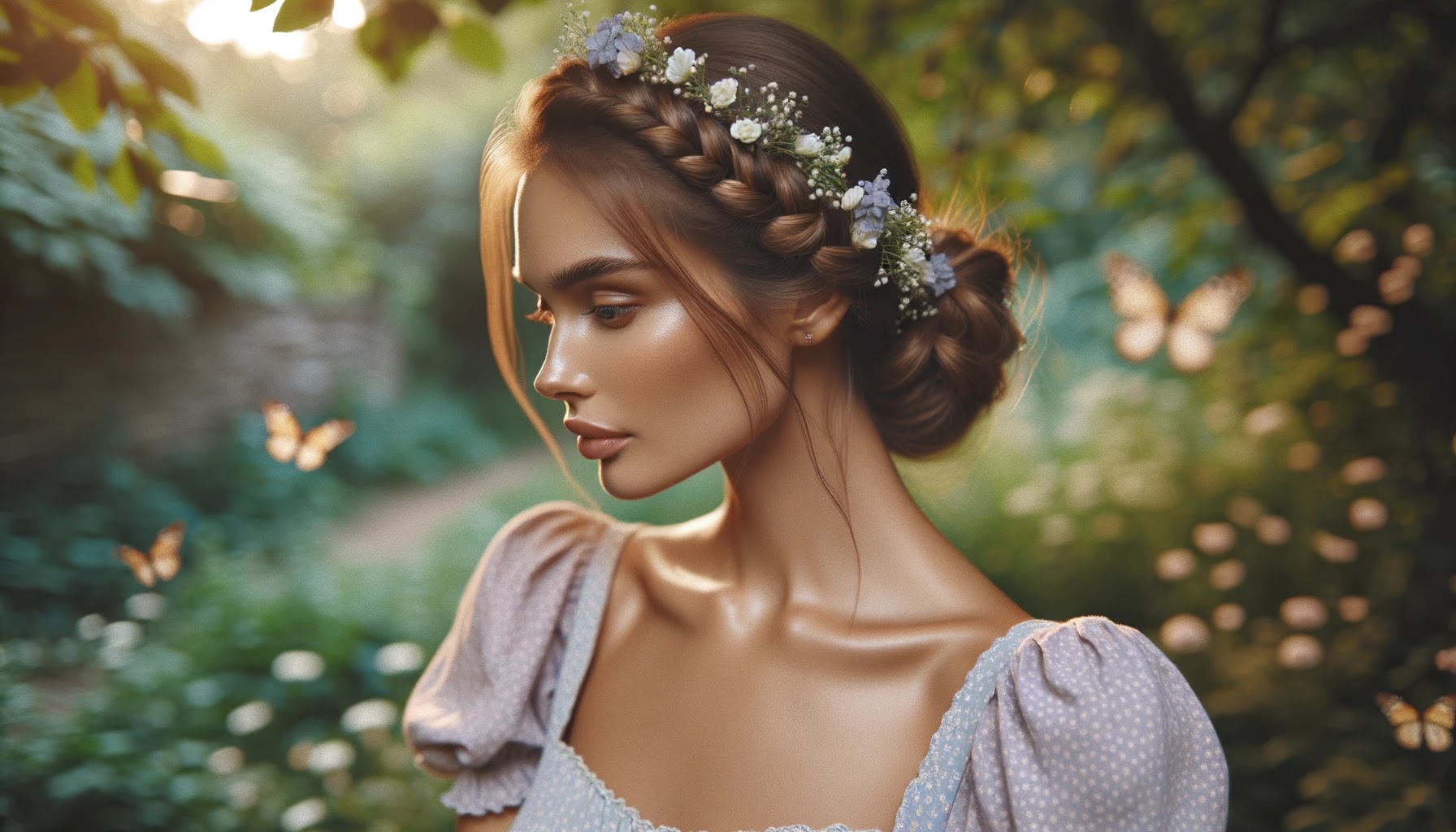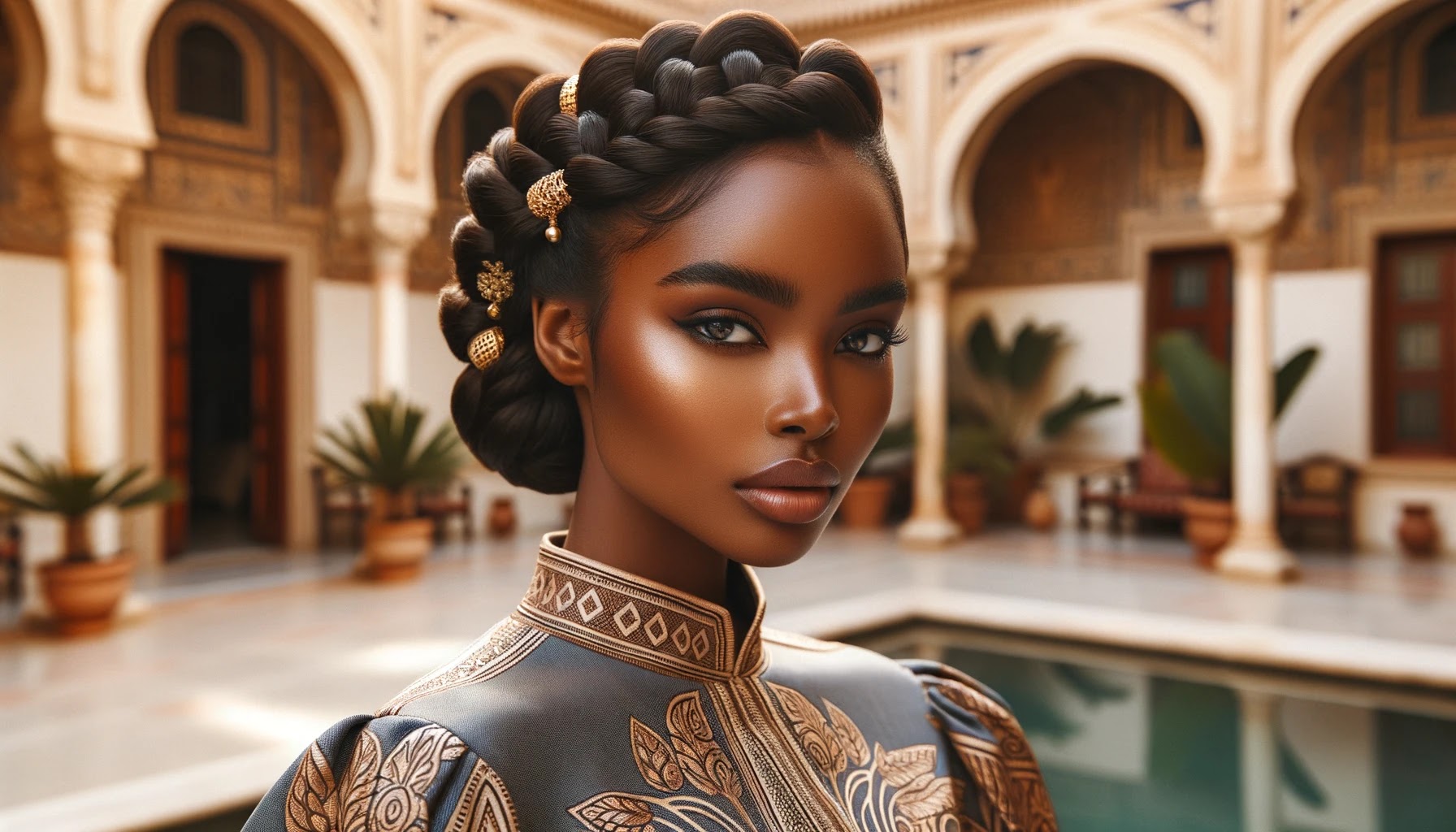The Dutch braid is an elegant hairstyle that appears complex but can be mastered with patience and practice. The braiding process entails intertwining three hair strands, but unlike the traditional French braid that involves crossing strands over one another, the strands are crossed beneath each other. This method results in a braid that lies atop the head, showcasing a more striking and defined look.
What is the origin of the Dutch braid?
The art of braiding was widespread in the ancient world, with evidence of various braiding techniques seen in artifacts from Ancient Greece, Egypt, and the Americas. Sculptures, frescoes, and figurines often depict women with elaborately braided hairstyles, indicating the prevalence and importance of braided hair in these cultures. The practice of braiding hair can be traced back to early African civilizations, nearly 5,000 years ago. Intricate braiding techniques were common among various tribes, often signifying a person's marital status, age, wealth, or social position.
South African women originally used the Dutch braid as a protective style for their hair. These braids were often complex and included multiple strands of hair. This braiding technique was adopted by the Dutch during Ivory Coast colonization in the 17th century and became known as a Dutch braid. Because of its versatility, this braid is popular for all hair types and ages. In Europe, braided hairstyles became popular during the Middle Ages and Renaissance periods. Intricate braids were often used as a means to control long hair, and they were especially prevalent among peasant and working-class women who needed practical hairstyles.
Over the centuries, the Dutch Braid has been adapted and modified, resulting in the myriad of variations we see today. During the 19th and early 20th centuries, the Dutch Braid became a popular style among European immigrants in North America, especially among communities seeking to maintain their cultural traditions.
In the 21st century, the Dutch Braid saw a resurgence in popularity.
Its aesthetic appeal and versatility make it a favorite choice for a
variety of occasions, from casual outings to formal events. Its unique,
3D appearance sets it apart from other braiding techniques, and it
serves as the base for numerous modern hairstyles, such as the Dutch
Braid Ponytail, Dutch Braid Updo, and the Dutch Crown Braid, among
others.
Variations and Adaptations
The Dutch braid is a versatile hairstyle that can be adapted to suit various occasions, hair lengths, and preferences. Some popular variations include:
1. Double Dutch Braid
Double Dutch braids are more than just a cool hairstyle; they're practical, versatile, and an excellent protective style for textured hair. They keep hair secure and protected from the elements, which can be particularly beneficial for those with delicate hair prone to breakage.
Moreover, Double Dutch braids are suitable for various occasions - from casual everyday wear to more formal events. They are highly customizable, allowing one to add their personal touch through embellishments or incorporating other hairstyles.Step 1: Prep Your Hair
Start with clean, detangled hair. You can either have your hair dry or damp, but keep in mind that braiding damp hair can create waves once dried and undone. Use a comb to part your hair down the middle, dividing it into two equal sections.
Step 2: Start Braiding
Starting from the hairline of one section, pick a small piece of hair and divide it into three equal strands. Begin your braid as you would a traditional braid, crossing the right strand under the middle strand, followed by the left strand under the new middle strand.
Step 3: Add More Hair
Now, you'll start incorporating more hair into your braid. When crossing the right strand under the middle, add some hair from the right side of your head into the strand. Do the same for the left side. Make sure to keep the braid tight to your scalp.
Step 4: Continue the Process
Keep repeating step 3, adding hair to each strand before crossing it under the middle strand. Ensure that you're keeping the braid tight and evenly pulling in the hair. Once you've incorporated all the hair from that section, continue with a traditional three-strand braid until you reach the end of the hair.
Step 5: Secure the Braid
Once you've reached the end, secure the braid with a hair tie. You can also choose to leave a few inches of your hair unbraided for a different look.
Step 6: Repeat on the Other Side
Repeat the same process on the other section of your hair. Try to keep both braids as symmetrical as possible.
Step 7: Final Touches
Now that you have your Double Dutch braids, you can choose to leave them as is for a more polished look, or you can gently pull at the loops of the braid to make them appear fuller and more voluminous.
2. Dutch Crown Braid
The Dutch Crown braid isn't just a hairstyle; it's a statement. It's an effective way to keep your hair secure while looking stylish. For those with long hair, it's an excellent option to manage your locks without resorting to the regular ponytail or bun.
Additionally, the Dutch Crown braid works as a protective style for textured and curly hair, reducing breakage by minimizing exposure to environmental elements. It's also a wonderful style for second or third-day hair, helping to conceal greasiness or flatness.Step 1: Preparation
Start with clean, detangled hair for the best results. You can work with either damp or dry hair, depending on your preference. Apply some mousse or a texturizing spray to give your hair a bit of grip, making it easier to manage.
Step 2: Create a Side Parting
Part your hair on one side. The side with more hair is where you'll start your braid.
Step 3: Begin Braiding
On the heavier side of your part, pick up a small section of hair near your forehead and divide it into three equal parts. Start with a regular braid by crossing the strands under the middle one (right under the middle, then left under the middle).
Step 4: Add Hair to Your Braid
Now, as you cross the right strand under the middle one, gather some additional hair from the right side and add it to the strand. Do the same with the left strand.
Step 5: Continue the Braiding Process
Maintain this pattern all around your head, adding more hair from your scalp into the braid as you go. Remember to keep the braid tight and close to your scalp for a neat appearance.
Step 6: Complete the Braid
Once you've incorporated all your hair into the braid, continue with a regular three-strand braid until you reach the end of your hair. Secure the braid with a small, clear elastic.
Step 7: Secure Your Crown
Now, tuck the tail of your braid under the start of your crown braid and secure it with bobby pins. Ensure that the pins aren't visible.
Step 8: Finishing Touches
For a more voluminous and relaxed look, gently tug at the loops of your braid. Use a hairspray to keep everything in place.
3. Dutch Mohawk Braid
One of the main attractions of the Dutch Mohawk braid is its versatility. It's an audacious and chic hairstyle that can be paired with a leather jacket for a rock concert or a floral dress for a summer picnic. It's also a practical choice for athletic activities as it keeps the hair secured tightly, preventing it from interfering with performance.
Another advantage of the Dutch Mohawk braid is that it's a protective hairstyle, especially for textured hair. It helps to reduce breakage and maintain the hair's health by minimizing exposure to harsh environmental elements.Step 1: Prepare Your Hair
Start with clean, dry, and well-detangled hair. Use a volumizing mousse or texturizing spray to give your hair a bit of hold and make it easier to work with.
Step 2: Section Your Hair
Using a comb, create a rectangular section at the top of your head, starting from your forehead and ending at the crown of your head. Secure the rest of your hair to keep it out of the way.
Step 3: Start the Dutch Braid
At the forehead end of your rectangular section, grab a small segment of hair and divide it into three strands. Begin a Dutch braid by crossing the right strand under the middle one, then the left strand under the new middle strand.
Step 4: Incorporate Additional Hair
As you continue to braid, add hair from the rectangular section into your braid. When crossing the right strand under the middle, add in some hair from the right side of your section. Do the same on the left side. Keep the braid tight to ensure it stays in place.
Step 5: Complete the Braid
Continue adding hair and braiding until you reach the end of the rectangular section at the crown of your head. Once you have incorporated all the hair in the section, continue with a regular three-strand braid until you reach the end of the hair. Secure the braid with a clear elastic.
Step 6: Release the Rest of the Hair
Now that the Dutch Mohawk braid is in place, you can release the rest of your hair.
Step 7: Add the Final Touches
For a more dramatic and voluminous effect, you can carefully tug on the loops of the braid to make it fuller. A little hairspray can help secure the braid and maintain its shape.
4. Dutch Fishtail Braid
The Dutch Fishtail Braid is both practical and versatile. It's a perfect option to keep your hair neatly tucked away, making it ideal for athletic activities or windy days. But it's not just about practicality — this hairstyle is a fashion statement on its own, adding a touch of elegance and intrigue to any look.
Moreover, the Dutch Fishtail Braid is a protective hairstyle, especially for curly or textured hair. By reducing exposure to harsh environmental elements, it helps minimize breakage and maintain the overall health of your hair.
Step 1: Prepare Your Hair
Begin with clean, dry, and well-detangled hair. Apply some mousse or texturizing spray to provide your hair with some grip, making it easier to work with.
Step 2: Create a Side Part
Part your hair on one side. The side with more hair is where you'll start your braid.
Step 3: Begin the Dutch Braid
Pick a small section from the front on the heavier side of your part. Divide this section into two equal parts. Now, take a thin strand from the outside of one of the two sections, cross it underneath, and add it to the inside of the other section.
Step 4: Add Hair to the Braid
As you continue this process, start incorporating additional hair into the braid from the sides. Make sure to keep the braid tight for a neat appearance.
Step 5: Continue the Braiding Process
Maintain this pattern all the way down, adding more hair into the braid as you go. Remember to always cross strands underneath — this is what gives it the Dutch braid effect.
Step 6: Secure the Braid
Once you've incorporated all your hair into the braid, continue with a regular fishtail braid until you reach the end of your hair. Secure it with a small, clear elastic.
Step 7: Final Touches
For a fuller and more relaxed look, carefully pull on the edges of your braid. This will make it appear more voluminous. A spritz of hairspray can help keep everything in place.
5. Dutch Braids with Extensions
Dutch braids, an "underhand" braiding technique, create an embossed, 3D effect, which stands out even more when the braid is thick and voluminous. While not everyone is blessed with a thick mane, extensions provide a viable solution. They not only add length and volume to the Dutch braids, but also allow you to experiment with color without altering your natural hair.
Another significant advantage of Dutch braids with extensions is their protective nature. When installed properly, extensions can shield your natural hair from environmental damage and reduce wear and tear caused by daily styling. This is particularly beneficial for individuals with textured hair, which is more susceptible to breakage.Step 1: Choose Your Extensions
Extensions come in a variety of types including clip-in, tape-in, sew-in, and more. For Dutch braids, clip-in or tape-in extensions are usually the most manageable. Choose extensions that closely match your hair color for a seamless blend, or opt for a contrasting color for a bold statement.
Step 2: Prepare Your Hair
Start with clean, detangled hair. Depending on your preference and hair type, you may want to blow-dry your hair for a sleek finish or leave it in its natural state for added texture.
Step 3: Install the Extensions
If you're using clip-in extensions, start at the nape of your neck and work your way up. Separate a thin section of hair, clip the extensions in, and let down another layer of your hair. Repeat the process until you reach the crown of your head.
For tape-in extensions, you'll need to sandwich thin sections of your hair between two extensions. Start at the roots and press the two extensions together. Like clip-ins, start at the bottom and work your way up.
Step 4: Section Your Hair
Divide your hair into two equal parts down the middle. Secure one side with a hair tie or clip to keep it out of the way.
Step 5: Start the Dutch Braid
On the loose side, pick up a small section of hair at the front. Divide this into three strands and start your Dutch braid. Remember, in a Dutch braid, the strands are crossed under each other, rather than over as in a French braid.
Step 6: Continue the Braid, Incorporating the Extensions
As you continue the braid, incorporate the extensions into the strands. Ensure that the wefts of the extensions are concealed within the braid.
Step 7: Secure the Braid
Once you've finished the braid, secure it at the end with an elastic. Repeat the process on the other side of your head.
Step 8: Finishing Touches
For a more relaxed look, you can gently pull on the edges of the braids to make them look fuller.
6. Dutch Waterfall Braid
The Dutch Waterfall Braid, as the name suggests, features a Dutch braid where sections of the hair are left hanging in a way that mimics a waterfall. The enchanting fall of the hair adds a fairy-tale like charm to the hairstyle, making it a popular choice for formal events, weddings, proms, and even casual gatherings.
Despite its complex appearance, a Dutch Waterfall Braid can be achieved with practice, transforming any hair length or type into a work of art. The hairstyle is not only stunningly attractive but is also a functional way to keep hair off the face while leaving most of it free-flowing.Step 1: Prep Your Hair
Begin with clean, dry, and well-detangled hair. If your hair is slippery, apply some texturizing spray or dry shampoo to provide grip and hold.
Step 2: Section Your Hair
Pick up a section of your hair from the front. If you're creating a side Dutch Waterfall Braid, start from the side with more hair.
Step 3: Start the Dutch Braid
Divide this section into three strands and start creating a Dutch braid. After one or two stitches of the braid, you will start incorporating the waterfall aspect.
Step 4: Create the Waterfall Effect
While continuing the braid, drop the strand on the bottom and replace it with a new section of hair directly behind it. This dropped strand creates the 'waterfall' effect.
Step 5: Continue the Braid
Continue the pattern along the side of your head, making sure to keep the braid tight for a neater appearance.
Step 6: Secure the Braid
Once you reach the back of your head, you can continue with a regular three-strand braid and secure it with a hair elastic. Alternatively, you could incorporate it into a bun or a ponytail for a different look.
Step 7: Final Touches
For a softer, fuller look, carefully tug on the edges of your braid. A light mist of hairspray can help hold everything in place.
7. Dutch Braided Bun
This hairstyle is ideal for those who desire an updo that not only looks appealing but also keeps hair securely tucked away. This makes it a favored choice for outdoor occasions, athletic activities, or on hot days when you want to keep your neck cool.
Additionally, the Dutch Braided Bun can also serve as a protective hairstyle, reducing exposure to environmental stressors and minimizing the potential for breakage and damage, particularly for individuals with textured or curly hair.Step 1: Prepare Your Hair
Start with clean, dry, and thoroughly detangled hair. For added texture and grip, consider applying a small amount of mousse or texturizing spray.
Step 2: Begin the Dutch Braid
Choose the location of your braid. It can either start from the nape of your neck or from the top of your head. If starting from the top, section off a portion of your hair and divide it into three strands. Begin creating a Dutch braid by crossing the outer strands under the middle strand.
Step 3: Continue the Braid
Continue adding hair from both sides as you braid downwards, making sure to cross the strands underneath each other to achieve the raised "Dutch" effect.
Step 4: Complete the Braid
Once you've incorporated all your hair into the braid, continue braiding the tail end as a standard three-strand braid. Secure the end with a small, clear elastic.
Step 5: Create the Bun
Wrap the braided tail around its base to create a bun. The positioning of the bun can be adapted to your preference — it can be a low bun at the nape of your neck, a high bun for a top knot effect, or even a side bun for an asymmetrical look.
Step 6: Secure the Bun
Secure the bun using bobby pins, making sure to tuck the ends neatly underneath. Depending on your hair's thickness and length, you might need several pins to ensure the bun stays put.
Step 7: Final Touches
For a more relaxed and voluminous look, gently pull apart the braid and bun using your fingers. A light mist of hairspray can help hold everything in place.
8. Dutch Braid Pigtails
Dutch Braid Pigtails are a popular hairstyle due to their versatility, youthful appeal, and practicality. The Dutch braid, also known as the reverse French braid, adds a unique, three-dimensional texture to the hair. When incorporated into pigtails, these braids offer a chic upgrade to the traditional childhood hairstyle.
Moreover, Dutch Braid Pigtails are extremely functional. They keep the hair securely tied back and out of the face, making them an ideal choice for sports, outdoor activities, or simply a hot summer day. Furthermore, when crafted carefully, Dutch Braid Pigtails also act as a protective style, safeguarding the hair from environmental stressors and damage.Step 1: Prepare Your Hair
Begin with clean, dry, and thoroughly detangled hair. A bit of texturizing spray can add grip and make it easier to manage the braiding process.
Step 2: Divide Your Hair
Using a comb, create a straight part down the middle of your head, dividing your hair into two equal sections.
Step 3: Start the Dutch Braid
Working on one side first, grab a small section of hair at the front and divide it into three strands. Start a Dutch braid by crossing the outer strands underneath the middle one.
Step 4: Continue the Braid
As you braid, keep adding hair from the sides into the braid, maintaining the undercrossing technique. This ensures the braid stands out from the head, creating the characteristic 'Dutch' effect.
Step 5: Complete the Braid
Once all the hair on one side is incorporated into the braid, continue to braid the lengths in a traditional three-strand braid and secure it with a hair tie. Repeat the process on the other side.
Step 6: Finishing Touches
For a more relaxed and fuller look, gently tug at the sides of the braids using your fingers. A light mist of hairspray can help secure your style for the day.
9. Side Dutch Braid
The side Dutch Braid combines the sophistication of the Dutch braid with a unique, asymmetric flair. Unlike traditional braids, which typically fall at the back of the head, the Side Dutch Braid sweeps hair to one side, creating a distinctive and stylish look.
Moreover, this hairstyle is incredibly practical. It keeps the hair neatly secured, making it an excellent choice for physical activities, hot weather, or those desiring a break from loose hair. Additionally, the side Dutch braid also serves as a protective style, helping reduce exposure to environmental damage.Step 1: Prepare Your Hair
Begin with clean, detangled hair. For added texture and easier braiding, consider applying a small amount of mousse or texturizing spray.
Step 2: Section Your Hair
Decide on which side you want your braid to fall. Then, section a piece of hair from that side of your parting.
Step 3: Start the Dutch Braid
Split this section into three equal strands. Begin creating a Dutch braid by crossing the two outer strands underneath the middle one.
Step 4: Continue the Braid
Continue the Dutch braid by adding more hair from both sides into the braid with each crossing. Always remember to cross the strands underneath each other to achieve the "Dutch" effect.
Step 5: Finish the Braid
Once all the hair is incorporated into the braid, finish it off as a traditional three-strand braid. Secure the end with a hair tie.
Step 6: Volumize the Braid
For a more relaxed and fuller appearance, carefully pull at the sides of the braid to loosen it. Finish off with a light mist of hairspray to keep everything in place.
10. Half-Up Dutch Braid
The Half-Up Dutch Braid offers a striking balance of style and function. By incorporating the intricacy of the Dutch braid into a half-up style, this hairstyle allows you to enjoy the best of both worlds - the sophistication of a braid and the freedom of loose hair.
Practical and versatile, the Half-Up Dutch Braid keeps your hair away from your face while leaving the rest of your hair free-flowing, making it a perfect choice for those seeking an elegant yet relaxed look. This hairstyle can transition effortlessly from day to night, from casual to formal, making it a favored choice among many.Step 1: Prepare Your Hair
Start with clean, dry, and well-detangled hair. Applying a small amount of mousse or dry shampoo can add texture and volume, making the braiding process easier.
Step 2: Section Your Hair
Grab a section of hair from the crown of your head. This section will be used to create your Dutch braid.
Step 3: Start the Dutch Braid
Split the selected section into three equal parts. Begin the Dutch braid by crossing the outer strands under the middle one.
Step 4: Continue the Braid
As you proceed with the braid, continue adding hair from the sides into the braid. Remember to keep crossing the strands under the middle one to maintain the Dutch braid's characteristic raised appearance.
Step 5: Secure the Braid
Once you reach the back-center of your head, you can stop adding in extra hair. Continue braiding the rest of the section in a regular three-strand braid and secure it with a clear elastic.
Step 6: Volumize the Braid
To achieve a fuller, more relaxed look, gently tug at the sides of the braid to loosen it slightly.
11. Dutch Braided Headband
The Dutch Braided Headband adds a touch of classic elegance to any hairdo, creating a striking visual impact. This hairstyle involves crafting a Dutch braid that wraps around the head like a headband, offering a creative and stylish way to keep hair away from the face.
Besides its aesthetic appeal, the Dutch Braided Headband is incredibly practical. This hairstyle is perfect for those active days when you want to keep your hair out of your face, as well as for formal events when you wish to exude a sense of elegance and sophistication. Moreover, the Dutch Braided Headband serves as a protective style, reducing exposure to environmental stressors and damage.Step 1: Prepare Your Hair
Start with clean, detangled hair. A bit of texturizing spray can help to add grip and volume, making the braiding process easier.
Step 2: Section Your Hair
Part your hair to one side. From the larger side, section off the front portion of hair that will be used for the braid.
Step 3: Start the Dutch Braid
Divide this section into three strands and begin a Dutch braid by crossing the outer strands underneath the middle one.
Step 4: Continue the Braid
As you continue the braid, remember to add in hair from the top and bottom into your braid to keep it attached to your head.
Step 5: Complete the Braid
Continue the braid until you reach the opposite ear. Once there, finish it off as a regular three-strand braid and secure it with an elastic.
Step 6: Secure the Braid
Wrap the braid around the back of your head and secure it behind your ear with bobby pins.
Step 7: Volumize the Braid
For a fuller look, gently pull at the sides of the braid to make it look thicker.
12. Dutch Braids with Bangs
Dutch Braids with Bangs offer a distinctive aesthetic that combines the intricacy of braids with the contemporary appeal of bangs. This hairstyle beautifully integrates the raised, three-dimensional look of Dutch braids with the soft, frame-enhancing qualities of bangs, striking a balance between classic and modern styles.
Apart from its visual appeal, Dutch Braids with Bangs is a practical hairstyle. It helps keep hair neatly secured and away from the face, making it a perfect choice for active individuals or those seeking a chic style that demands little maintenance throughout the day. Moreover, it works as a protective hairstyle, minimizing exposure to environmental damage and reducing wear and tear caused by regular heat styling.Step 1: Prepare Your Hair
Begin with clean, detangled hair. A bit of texturizing spray can provide extra grip, making the braiding process smoother.
Step 2: Section Your Hair
Partition your hair according to where you want your braids to start. Be sure to leave out your bangs or the front section of your hair if you wish to create artificial bangs.
Step 3: Start the Dutch Braid
Take a section of hair from the top, split it into three equal parts, and begin your Dutch braid. Remember to cross the strands underneath the middle one to get the characteristic raised Dutch braid effect.
Step 4: Continue the Braid
As you braid, add in hair from both sides. Make sure you incorporate all the hair into your braids, leaving out only the bangs.
Step 5: Secure the Braid
Once you've braided all your hair, secure the ends with hair ties.
Step 6: Style the Bangs
Depending on the type of bangs you have or want, style them accordingly. You may straighten, curl, or simply brush them out for a more natural look.
13. Dutch Braid Updo
The Dutch Braid Updo is a remarkable hairstyle, radiating an air of refinement and grace. It's a composition of Dutch braids, known for their "pop-out" effect, styled into an updo, be it a bun, a chignon, or a tucked tail, to give a polished finish.
Practicality and versatility are at the heart of this hairstyle. The Dutch Braid Updo keeps the hair firmly in place, making it an ideal style for dynamic individuals or for those seeking a low-maintenance, yet chic look. From casual days out to formal events, the Dutch Braid Updo transitions seamlessly, adding a touch of elegance to any ensemble.Step 1: Prepare Your Hair
Start with clean, detangled hair. Applying a texturizing spray can add volume and make the hair more manageable for braiding.
Step 2: Section Your Hair
Decide where you want your braids to start and section your hair accordingly. You can opt for a middle part, side part, or no part at all, depending on your preference.
Step 3: Start the Dutch Braid
Take a section of hair from the top, divide it into three equal parts, and start your Dutch braid by crossing the outer strands underneath the middle one.
Step 4: Continue the Braid
As you braid, add in hair from both sides to keep the braid attached to the head.
Step 5: Secure the Braid
Once you've braided all your hair, secure the ends with hair ties.
Step 6: Craft the Updo
Now, shape your braids into your desired updo. You might wrap the braids into a bun, tuck them under to create a chignon, or even create a braided crown. Secure the updo with bobby pins.
Step 7: Finish the Look
For a more voluminous look, gently tug on the braids to loosen them slightly. Apply a light spritz of hairspray to ensure the hairstyle stays in place.
14. Dutch Braid Ponytail
The Dutch Braid Ponytail is a harmonious fusion of the three-dimensional effect of Dutch braids with the relaxed charm of a ponytail. It presents a balance between the complexity of braids and the simplicity of ponytails, resulting in a hairstyle that exudes both elegance and nonchalance.
In addition to its aesthetic appeal, the Dutch Braid Ponytail is an exceptionally practical hairstyle. It effectively keeps the hair out of the face, making it a perfect choice for those who lead active lives or prefer a low-maintenance style. Moreover, this hairstyle acts as a protective measure, shielding hair from environmental stressors and damage.Step 1: Prepare Your Hair
Start with clean, well-combed hair. Adding a texturizing spray can provide extra volume, making the hair more manageable.
Step 2: Section Your Hair
Part your hair based on where you want the braid to start. You may choose a center or side part depending on your preference.
Step 3: Start the Dutch Braid
Pick a section of hair from the top, divide it into three equal strands, and commence your Dutch braid by crossing the outer strands underneath the middle one.
Step 4: Continue the Braid
As you braid, incorporate hair from both sides to keep the braid anchored to your head.
Step 5: Transition to a Ponytail
Once the braid reaches the crown or back of your head, gather all the hair into a ponytail. Secure the ponytail with a hair tie.
Step 6: Finishing Touches
For a fuller look, slightly pull apart the braid to add volume. For a sleek finish, smooth out the ponytail with a brush.
What are the benefits of a Dutch braid?
Functionality
One of the primary benefits of the Dutch braid is its functionality. This hairstyle keeps hair neatly tucked away and under control, making it an ideal option for those with active lifestyles. The Dutch braid's secure hold ensures that hair stays in place during physical activities such as sports, dancing, and workouts, while also protecting it from environmental factors like wind and humidity.
Low Maintenance
The Dutch braid is a low-maintenance hairstyle that requires minimal upkeep once completed. Unlike loose hairstyles, which may necessitate frequent touch-ups and adjustments, the Dutch braid maintains its appearance throughout the day with little to no intervention. Additionally, as the braid keeps hair off the face and neck, it can help keep you cool during warmer months or intense physical activities.
Protects Hair from Damage
Dutch braids can serve as a protective hairstyle, shielding hair from damage caused by excessive heat styling, friction, and environmental factors. By keeping hair securely braided, it minimizes breakage, tangling, and split ends, ultimately promoting healthier hair in the long run. This makes Dutch braids an excellent choice for those aiming to grow their hair or simply maintain its health.
Adaptability
The adaptability of the Dutch braid is another significant benefit. It can be styled in numerous ways to suit various occasions, from casual outings to formal events. The Dutch braid's versatility allows for a wide range of creative adaptations, such as double Dutch braids, crown Dutch braids, side Dutch braids, Dutch braid updos, and Dutch fishtail braids. This adaptability ensures that there is a Dutch braid style for everyone, regardless of personal preferences.
Suitable for All Hair Types
The Dutch braid is a hairstyle that works well with all hair types – from straight to curly and everything in between. Whether you have fine or thick hair, the Dutch braid can be easily adjusted to accommodate different hair textures and densities. By gently tugging on the edges of the braid, you can create a fuller, more voluminous appearance for those with thinner hair, while those with thicker hair can maintain the braid's structure without compromising its integrity.
Timeless Elegance
The Dutch braid's timeless elegance makes it a popular choice for special occasions and events. Its intricate appearance adds a touch of sophistication and grace to any look, making it an excellent choice for weddings, proms, and other formal gatherings. Moreover, the Dutch braid's classic style ensures that it will never go out of fashion, making it a worthwhile hairstyle to master.
Encourages Hair Growth
As previously mentioned, Dutch braids protect hair from damage and breakage, ultimately promoting healthier hair. Additionally, the gentle tension created by the braiding process can stimulate blood flow to the scalp, which may encourage hair growth and improve overall scalp health.
Dutch Braid for Different Types of Hair
The Dutch Braid, a timeless and popular hairstyle, has proven its versatility across a spectrum of hair types - curly, short, and thin included. Contrary to popular belief, these hair types can be transformed into a stunning Dutch braid with the right techniques. In this article, we delve into how these hair types can flaunt the Dutch braid, with some handy styling tips to boot.
The Dutch Braid for Curly Hair:
Curly hair adds a unique texture and volume to any hairstyle, and the Dutch braid is no exception. Here's how you can achieve a stunning Dutch braid with curly hair:
- Preparation: Start by detangling your curls using a wide-toothed comb or your fingers. This will help make the braiding process smoother and prevent tangles.
- Sectioning: Divide your hair into three equal sections at the top of your head, just like you would for a regular braid.
- Braiding Technique: Instead of crossing the strands over each other, cross them under. This will create the distinctive raised effect of the Dutch braid. Continue this technique as you incorporate more hair into the braid along the hairline.
- Loosen the Braid: Once you have finished braiding all the way down, gently pull on the edges of the braid to loosen it. This will give your Dutch braid a voluminous and effortless appearance.
- Enhancing Curls: If you want to enhance the curly texture of your Dutch braid, you can apply a curl-enhancing mousse or serum before braiding. This will add definition and help your curls stay intact throughout the day.
The Dutch Braid for Short Hair:
Contrary to popular belief, the Dutch braid can be achieved on shorter hair lengths as well. While it may require some adaptability, the results can be equally stunning. Here's how to create a Dutch braid on short hair:
- Preparing the Hair: If your hair is too short to be divided into three sections, you can create a mini Dutch braid. Start by parting your hair slightly to one side, and section off a small segment of hair at the front.
- Braiding Technique: Begin the braid by crossing the strands under each other, just like with the regular Dutch braid. As you continue, incorporate small sections of hair into the braid, picking up hair from the sides to add volume and texture.
- Secure the Braid: Once you reach the end, secure the braid with a small hair elastic or bobby pins. You can also use a bit of hairspray to hold any loose strands in place.
- Accessorize: Short hair can be transformed with the addition of stylish accessories. Consider adding small decorative pins or headbands to enhance the look of your Dutch braid.
The Dutch Braid for Thin Hair:
For those with thin hair, the Dutch braid can be an excellent way to add volume and depth to your hairstyle. Here's how to create a Dutch braid that gives the illusion of fuller hair:
- Add Volume: To give your hair more body, start by applying a volumizing mousse or dry shampoo to the roots. This will help create texture and make the braid appear thicker.
- Tease the Hair: Gently tease the hair at the crown of your head using a teasing comb or brush. This will add height and volume to the braid.
- Braid Technique: Begin the Dutch braid by following the standard technique of crossing the strands under each other. Incorporate small sections of hair as you work your way down, ensuring that you pull on the edges of the braid to create a fuller appearance.
- Use Hair Extensions: If you desire a longer or thicker Dutch braid, consider using clip-in hair extensions. They can add length and volume, allowing you to achieve your desired look.
- Texturizing Spray: After braiding, apply a texturizing spray to the braid and gently pull on the edges to create a fuller effect. This will give your thin hair a more voluminous appearance.
Dutch Braid vs. French Braid
While they may appear similar at first glance, there are some key differences that set them apart.
Braiding Technique:
The most significant difference between the Dutch braid and the French braid lies in the braiding technique used:
Dutch Braid: The Dutch braid, also known as an inverted or inside-out braid, involves crossing the strands under each other instead of over. This creates a raised effect, with the strands appearing on top of the braid rather than underneath.
French Braid: The French braid, on the other hand, is a standard braid that involves crossing the strands over each other. This technique creates a sleek, flat braid with the strands appearing underneath.
Appearance:
The contrasting braiding techniques result in different appearances for the Dutch braid and the French braid:
Dutch Braid: The Dutch braid has a distinct three-dimensional appearance. The strands appear on top of the braid, creating a raised, textured effect. This braid style adds volume and can be easily seen from different angles.
French Braid: The French braid has a flatter appearance. The strands are woven underneath, giving the braid a smooth and sleek look. The French braid lays close to the scalp and is known for its neat and polished appearance.
Placement:
Another difference between the Dutch braid and the French braid is their placement on the head:
Dutch Braid: The Dutch braid is often placed closer to the hairline or on the crown of the head. It can be braided down the back or to the side, creating a striking and eye-catching style.
French Braid: The French braid is typically started at the crown of the head and follows the natural hairline. It can be braided down the back or styled into various placements, such as a side braid or a braided updo.
Versatility:
Both the Dutch braid and the French braid offer versatility in terms of styling options:
Dutch Braid: The raised and textured appearance of the Dutch braid makes it ideal for creating a bold and statement-making look. It can be incorporated into various hairstyles, such as ponytails, updos, or half-up styles, to add texture and volume.
French Braid: The French braid's sleek and polished look lends itself well to both casual and formal hairstyles. It can be worn as a standalone braid or combined with other braiding techniques to create intricate and elegant updos.
Hair Texture:
The Dutch braid and the French braid can be adapted to suit different hair textures:
Dutch Braid: The Dutch braid works well on most hair textures, including straight, wavy, and curly hair. It is particularly beneficial for showcasing curly hair due to its raised appearance, adding definition and visual interest to the braid.
French Braid: The French braid is versatile and can be created on various hair textures. It works well on straight and wavy hair, providing a sleek and elegant look. However, it may require some additional steps or products to hold securely on very fine or slippery hair.
Deciding Factors: Making the Right Choice
Choosing between a Dutch braid and a French braid depends on several aspects ranging from the occasion, personal style, hair type, and even your comfort level with braiding. Here's what you need to consider:
- The Occasion: Your hairstyle should complement the occasion. Dutch braids, with their pronounced, bold aesthetic, are a perfect fit for informal or casual events. They're also ideal for sports activities, where you want your hair secured but with an element of style. French braids, on the other hand, exude an elegant vibe that is apt for more formal settings such as corporate events, weddings, or fine dining experiences.
- Personal Style: Consider your personal fashion sense and how a hairstyle fits into your overall look. If you prefer a daring, standout style, the Dutch braid's raised, noticeable design would align with your aesthetics. Alternatively, if your style leans more towards classic and refined, the subtle, seamless appearance of a French braid would better suit you.
- Hair Type: Your hair type could also influence your decision. Dutch braids can give the illusion of thicker hair due to their raised structure and hence, could be a great choice for those with thin hair. On the other hand, French braids, lying flat against the scalp, work beautifully with all hair types, and are particularly easy to handle for those with thick, long hair.
- Comfort and Skill: Both Dutch and French braids require a degree of practice to master. If you are new to braiding, you might find it easier to start with French braids as they offer a more intuitive braiding process. Once you are comfortable with French braids, you can then try your hand at Dutch braids, which require a slightly more complex braiding technique.
Are Dutch braids easy to maintain?
Let’s examine the various aspects of Dutch braid maintenance, including factors that affect the ease of upkeep, and how to ensure your Dutch braids remain fresh and stylish:
Factors Affecting Dutch Braid Maintenance
Several factors can influence the ease of maintaining Dutch braids, including hair type, length, skill level, maintenance products, sleeping habits, and activity level.
- Hair Type: Your hair type plays a crucial role in how effortless it is to maintain Dutch braids. Individuals or wavy hair might find it easier to maintain the style due to the hair's lower tendency to tangle. However, those with curly or kinky hair might face more challenges in maintaining the style because their hair can be harder to manage.
- Length: Hair length also impacts Dutch braid maintenance. Shorter hair may be easier to maintain because it is less likely to tangle or catch on objects. On the other hand, those with longer hair might find it more difficult to maintain because it is more prone to tangling.
- Skill Level: Your experience with braiding will also affect the ease of maintaining Dutch braids. If you are new to braiding or have never tried Dutch braids before, you might find it more challenging to maintain the style. However, with practice and patience, you can learn how to create and maintain Dutch braids effortlessly.
- Maintenance Products: Utilizing appropriate maintenance products can significantly enhance the ease of maintaining Dutch braids. For instance, using a detangler or leave-in conditioner can help prevent tangling and make hair management easier. Additionally, applying hairspray or other styling products can help keep the braids intact and prevent them from unraveling.
- Sleeping Habits: The way you sleep can also influence Dutch braid maintenance. Wrapping your hair in a silk or satin scarf while sleeping can help prevent tangling and keep the braids in place. Elevating your head during sleep can help avoid the braids from becoming flat or misshapen.
- Activity Level: Lastly, your activity level can affect Dutch braid maintenance. If you have an active lifestyle, you might find it more challenging to maintain the style, as the braids can become undone or tangled during physical activities. Using a headband or hair tie can help keep the braids in place and prevent them from becoming disheveled.
Tips for Maintaining Dutch Braids
By considering the factors mentioned above, you can take specific steps to ensure your Dutch braids stay fresh and stylish.
- Practice braiding techniques: As with any skill, practice makes perfect. The more you practice Dutch braiding, the easier it will be to create and maintain the style.
- Choose appropriate hair products: Invest in high-quality hair products that suit your hair type and texture. These products will help maintain the integrity of your Dutch braids and keep them looking fresh.
- Protect your braids while sleeping: To preserve your Dutch braids overnight, wrap your hair in a silk or satin scarf or use a silk or satin pillowcase to minimize friction and prevent tangles.
- Be mindful of your activities: If you lead an active lifestyle, take extra precautions to ensure your Dutch braids remain intact. Secure your braids with a headband or hair tie, and consider wearing a protective cap during activities that could cause your braids to become disheveled.
In wrapping up, the Dutch braid is more than just a hairstyle; it's a fusion of art, tradition, and personal expression. While it might seem intricate and challenging at first glance, with a bit of practice, it's entirely achievable at home. Whether you're going for an elegant look for a special occasion or aiming for a sporty, hassle-free style, the Dutch braid offers versatility and lasting impression. So grab a mirror, some hair ties, and perhaps a friend to help you out the first few times, and dive into the rewarding craft of Dutch braiding. Once you've mastered it, the possibilities for creative and functional hairstyling are virtually limitless.





















0 Comments